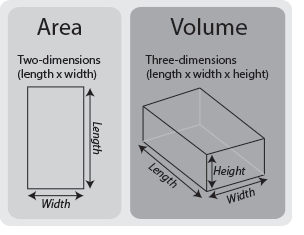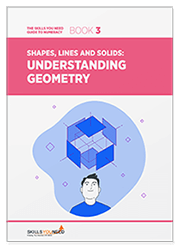Calculating Volume
See also: Three-Dimensional ShapesThis page explains how to calculate the volume of solid objects, i.e. how much you could fit into an object if, for example, you filled it with a liquid.
Area is the measure of how much space there is within a two dimensional object (see our page: Calculating Area for more).
Volume is the measure of how much space there is within a three-dimensional object. Our page on three-dimensional shapes explains the basics of such shapes.
In the real world, calculating volume is probably not something that you will use as often as calculating area.
However it can still be important. Being able to calculate volume will enable you to, for example, work out how much packing space you have when moving house, how much office space you need, or how much jam you can fit into a jar.
It can also be useful for understanding what the media mean when they talk about the capacity of a dam or the flow of a river.

A Note on Units
Area is expressed in square units (2), because it is it is measured in two dimensions (e.g. length × width).
Volume is expressed in cubic units (3), because it is measured in three dimensions (e.g. length × width × depth). Cubic units include cm3, m3 and cubic feet. Cubic units include cm3, m3 and cubic feet.
WARNING!
Volume can also be expressed as liquid capacity.
Metric System
In the metric system liquid capacity is measured in litres, which is directly comparable with the cubic measurement, since 1ml = 1cm3. 1 litre = 1,000 ml = 1,000cm3.
Imperial/English System
In the imperial/English system the equivalent measurements are fluid ounces, pints, quarts and gallons, which are not easily translated into cubic feet. It is therefore best to stick to either liquid or solid volume units.
For more, see our page on Systems of Measurement.
Basic Formulae for Calculating Volume
Volume of Rectangle-Based Solids

Whereas the basic formula for the area of a rectangular shape is length × width, the basic formula for volume is length × width × height.
How you refer to the different dimensions does not change the calculation: you may, for example, use 'depth' instead of 'height'. The important thing is that the three dimensions are multiplied together. You can multiply in which-ever order you like as it won't change the answer (see our page on multiplication for more).
A box with the dimensions 15cm width, 25cm length and 5 cm height has a volume of:
15 × 25 × 5 = 1875cm3
Volume of Prisms and Cylinders
This basic formula can be extended to cover the volume of cylinders and prisms too. Instead of a rectangular end, you simply have another shape: a circle for cylinders, a triangle, hexagon or, indeed, any other polygon for a prism.
Effectively, for cylinders and prisms, the volume is the area of one side multiplied by the depth or height of the shape.
The basic formula for volume of prisms and cylinders is therefore:
Area of the end shape × the height/depth of the prism/cylinder.
Watch out for inconsistent units!
A straight length of circular pipe has an internal diameter of 2cm and a length of 1.7m. Calculate the volume of water in the pipe.
In this example you need to calculate the volume of a very long, thin cylinder, that forms the inside of the pipe. The area of one end can be calculated using the formula for the area of a circle πr2. The diameter is 2cm, so the radius is 1cm. The area is therefore π × 12, which is 3.14cm2.
The length of the pipe is 1.7m, so you need to multiply the end area by the length in order to find the volume.
Watch out for inconsistent units! The area is in centimetres, but the length is in metres. First convert the length into cm 1.7 × 1000 = 1700cm.
The volume is therefore 3.14 × 1700 = 5338 cm3. This is equivalent to 5.338 litres, or 0.0053 m3.
Volume of Cones and Pyramids
The same principle as above (width × length × height) holds for calculating the volume of a cone or a pyramid except that, because they come to a point, the volume is only a proportion of the total that it would be if they continued in the same shape (cross-section) right through.
The volume of a cone or pyramid is exactly one third of what it would be for a box or cylinder with the same base.
The formula is therefore:
Area of the base or end shape × the height of the cone/pyramid × 1/3
Refer back to our page Calculating Area if you cannot remember how to calculate the area of a circle or triangle.
For example, to calculate the volume of a cone with a radius of 5cm and a height of 10cm:
The area within a circle = πr2 (where π (pi) is approximately 3.14 and r is the radius of the circle).
In this example, area of base (circle) = πr2 = 3.14 × 5 × 5 = 78.5cm2.
78.5 × 10 = 785
785 × 1/3 = 261.6667cm3

Volume of a Sphere
As with a circle, you need π (pi) to calculate the volume of a sphere.
The formula is 4/3 × π × radius3.
You may be wondering how you could work out the radius of a ball. Short of sticking a knitting needle through it (effective, but terminal for the ball!), there is a simpler way.
You can measure the distance around the widest point of the sphere directly, for example, with a tape measure. This circle is the circumference and has the same radius as the sphere itself.
The circumference of a circle is calculated as 2 x π x radius.
To calculate the radius from the circumference you:
Divide the circumference by (2 x π).
Worked Examples: Calculating Volume
Example 1

Calculate the volume of a cylinder with a length of 20cm, and whose circular end has a radius of 2.5cm.
First, work out the area of one of the circular ends of the cylinder.
The area of a circle is πr2 (π × radius × radius). π (pi) is approximately 3.14.
The area of an end is therefore:
3.14 x 2.5 x 2.5 = 19.63cm2
The volume is the area of an end multiplied by the length, and is therefore:
19.63cm2 x 20cm = 392.70cm3

Example 2
Which is bigger by volume, a sphere with radius 2cm or a pyramid with base 2.5cm square and height of 10cm?
First, work out the volume of the sphere.
The volume of a sphere is 4/3 × π × radius3.
The volume of the sphere is therefore:
4 ÷ 3 x 3.14 × 2 × 2 × 2 = 33.51cm3
Then work out the volume of the pyramid.
The volume of a pyramid is 1/3 × area of base × height.
Area of base = length × breadth = 2.5cm × 2.5cm = 6.25cm2
Volume is therefore 1/3 x 6.25 × 10 = 20.83cm3
The sphere is therefore larger by volume than the pyramid.
Calculating the Volume of Irregular Solids
Just as you can calculate the area of irregular two-dimensional shapes by breaking them down into regular ones, you can do the same to calculate the volume of irregular solids. Just split the solid up into smaller parts until you reach only polyhedrons that you can work with easily.
Worked example
Calculate the volume of a water cylinder with total height 1m, diameter of 40cm, and whose top section is hemispherical (half of a sphere).

You first divide the shape into two sections, a cylinder and a hemisphere.
The volume of a sphere is 4/3 × π × radius3. In this example the radius is 20cm (half the diameter). Because the top is hemispherical, its volume will be half that of a full sphere. The volume of this section of the shape therefore:
0.5 × 4/3 × π × 203 = 16,755.16cm3
The volume of a cylinder is area of the base × height. Here, the height of the cylinder is the total height less the radius of the sphere, which is 1m – 20cm = 80cm. The area of the base is πr2.
The volume of the cylindrical section of this shape is therefore:
80 × π × 20 × 20 = 100,530.96cm3
The total volume of this water container is therefore:
100,530.96 + 16,755.16 = 117,286.12cm3.
This is quite a large number, so you may prefer to convert it to 117.19 litres by dividing by 1,000 (since there are 1000cm3 in a litre). However, it is quite correct to express it as cm3 since the problem does not ask for the answer to be expressed in any particular form.
Further Reading from Skills You Need
Understanding Geometry
Part of The Skills You Need Guide to Numeracy
This eBook covers the basics of geometry and looks at the properties of shapes, lines and solids. These concepts are built up through the book, with worked examples and opportunities for you to practise your new skills.
Whether you want to brush up on your basics, or help your children with their learning, this is the book for you.
In Conclusion…
Using these principles, if necessary, you should now be able to calculate the volume of almost anything in your life, whether that’s a packing crate, a room, or a water cylinder.

